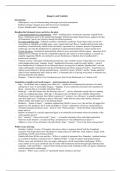Imagery and Symbols
Introduction
- Shakespeare’s way of communicating stereotypes and racial assumptions
- Richness of Iago’s imagery gives him the power to manipulate
- Rymer: Handkerchief’s importance is overstated
Handkerchief (dramatic irony and drives the plot)
- Visual representation for consummation - cloth = wedding sheets, strawberries represent virginal blood:
Boose “emblematic proof of the marital blood pledge” (biblical precedent Deuteronomy, supports the idea
of Desdemona’s purity and virginity through its biblical presence)
- D’s purity and their unity - European countries, strawberries symbolize Virgin Mary (often carved into
stone pillars in cathedrals in middle ages) - pure, virginal and loyal; Boose - handkerchief presents unity;
strawberry is horticulturally related to the rose family, represents love, romance, promise of generation,
reinforcing view that the handkerchief is significant in representing Desdemona’s unjust murder by O
- Female deception - strawberries horticulturally related to rose, associated with the serpent - represents devil,
original sin, Eve blamed for the fall of mankind (represents all women’s in-built tendency to commit sin,
arguably suggesting Othello was destined to accuse Desdemona of adultery due to handkerchief’s
promiscuous message)
- Venetian women’s stereotype of disloyalty/promiscuity: since symbols of pure Virgin Mary are sown onto
white handkerchief using “maidens’ hearts”, handkerchief becomes symbol of purity/fidelity – when D
loses handkerchief, O interprets this as disloyalty/deceit, accusing her of adultery (handkerchief’s red and
white could signify consummation, but that of Desdemona and Cassio instead of with O + strawberries are
implicit sexual allusion to female genitalia Boose - strawberry means “fertility” and the “female genitalia” -
when D loses handkerchief and it ends up with C, O interprets this as D giving away purity to someone else,
showing disloyalty and adultery
- Hodgson - “when the object is lost, Desdemona goes from divine Desdemona to a Venetian wife”
Animalistic, prejudice and racial imagery – monstrous/monster imagery
- Iago - “an old black ram is tupping your white ewe” – implies he is corrupting the innocence of a lamb,
calling him a “ram” is zoomorphic imagery. “Tupping” is most commonly associated with copulation of
sheep – presents him as a sexually animalistic being
- Roderigo - “what full fortune does the thick lips owe us?” – plosive alliteration sounds like he is spitting
words out, emphasizing anger; ‘thick lips’ is derogatory slur on Othello’s race; Othello influenced by
Desdemona’s dowry (payment from father to groom in 17 century); Leo Africanus “so greedily addicted
unto their filthy lucre”. Referring to him as “thick-lips” rather than by name strips identity, dismisses
military ability and assigns race as his defining feature
- Brabantio - “chains of magic” – metaphor emphasizing Othello’s power over wife and how he trapped her
against her will; predatory, she is weak and helpless; “chains” connotations of slavery; strong beliefs in
witchcraft amongst Jacobean society - James I wrote “Daemonologie” – belief that black connoted black
magic and evil
- Burnett “he himself is a racially oppressed figure in an unfamiliar environment where the attitudes of the
white majority prevail”
- End - “monster”; “foam at the mouth”, “gnaw” – eventually internalises these and adopts animalistic
behaviour (calls himself a “circumciséd dog” and promises to “tear [Desdemona] to pieces”)
- Adheres to views of Leo Africanus who calls blacks “dogs”, “beastly”, “lives in the forest among beasts”
Willow scene and song
- Saunders; “pathos” reverse of Cleopatra who puts on robes to empower herself with her triumphant
encounter with death (shows how Desdemona is being reduced to child-like, weak, helpless, fragile, frail),
sacrificing yourself versus being sacrificed
- Ophelia falls from Willow tree and dies – Willow is symbol of unrequited love (Saunders “emblem function
as a symbol of forsaken or betrayed love”), Ophelia; Willow = image of sadness and female betrayal
- Willow scene only included in folio, not quarto, making her critical interpretation challenging. Willow
scene enables us to access emotional side of Emilia with Desdemona shown through high emotional state
(singing) - both sing Willow – united in their emotional state (only included in folio, not quarto, making her
critical interpretation challenging)
- Saunders - Willow scene consists of “specifically female substance and tone”




